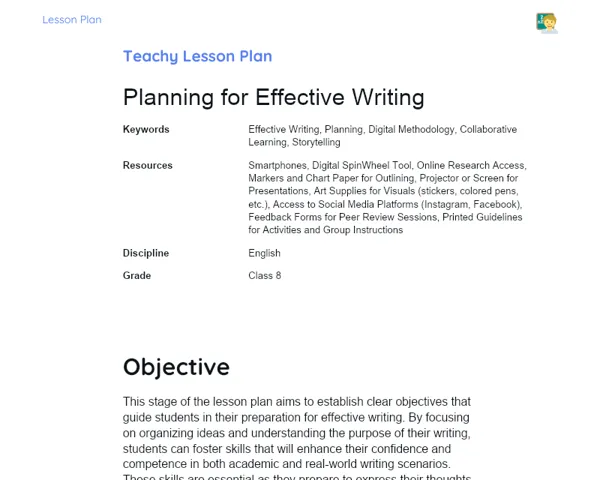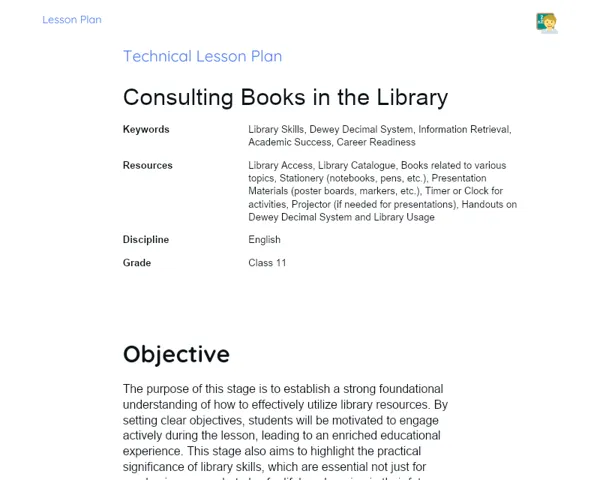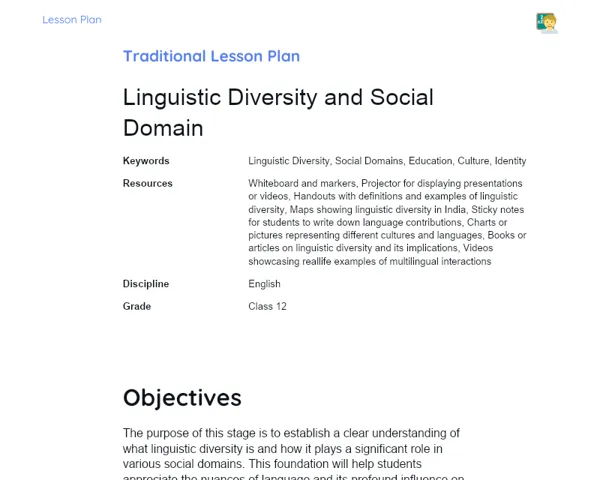Lesson Plan | Socioemotional Learning | Vocabulary: Fun and Leisure
| Keywords | Vocabulary, Fun, Leisure, English, 8th grade, Self-knowledge, Self-control, Responsible Decision Making, Social Skills, Social Awareness, RULER, Guided Meditation, Leisure Journal, Reflection, Emotional Regulation, Personal Goals |
| Resources | Sheets of paper, Pens, Comfortable chairs, Meditation space, Whiteboard, Markers, Audiovisual resources (optional) |
| Codes | - |
| Grade | 8th grade |
| Discipline | English |
Objective
Duration: 10 to 15 minutes
This stage aims to give students a clear understanding of the lesson's objectives, emphasizing the significance of vocabulary related to leisure and hobbies. This sets the groundwork for upcoming activities, fostering a learning atmosphere that nurtures both emotional and linguistic growth, enabling students to personally connect with the topic and see its relevance in everyday life.
Objective Utama
1. Enhance English vocabulary related to leisure, hobbies, and enjoyment.
2. Develop the capacity to recognize and use specific words and phrases to describe leisure activities.
Introduction
Duration: 15 to 20 minutes
Emotional Warmup Activity
Finding Calm
Guided Meditation
1. Tell students to sit comfortably in their chairs with their feet flat on the floor and hands resting on their laps.
2. Instruct students to close their eyes and concentrate on their breathing. Ask them to take deep breaths, inhaling through their nose and exhaling through their mouth.
3. Guide students to imagine a peaceful place where they feel secure and at ease. It could be a beach, a quiet hill station, a garden, or any space that grants them peace.
4. Continue leading them through a calming visualization, describing details of their chosen environment, while urging them to notice sounds, scents, and feelings.
5. After a few minutes of visualization, gently prompt students to return their focus to the classroom, opening their eyes when they feel ready.
6. Wrap up the activity by inviting students to share how they felt during the meditation and if it helped them concentrate more.
Content Contextualization
Having a strong vocabulary related to leisure, hobbies, and enjoyment is vital for effective communication in English, as it allows us to share our personal passions and interests with others. Just imagine how enjoyable it would be to discuss your favorite pastimes or plan fun activities with friends from different places! Additionally, using this vocabulary helps students develop social and emotional skills, enabling them to express themselves clearly and understand the interests of others, thus fostering stronger and more meaningful social connections.
Development
Duration: 60 to 75 minutes
Theory Guide
Duration: 15 to 20 minutes
1. ### Key Components of Vocabulary: Fun and Leisure
2. Definitions and Examples
3. Hobbies: Activities that people love doing in their free time. Examples: painting, reading, gardening.
4. Leisure Activities: Activities done for relaxation and enjoyment. Examples: watching movies, playing sports, traveling.
5. Leisure Places: Locations where people can have fun or unwind. Examples: amusement parks, beaches, libraries.
6. Analogies and Comparisons
7. Comparing hobbies and jobs: Just like a profession may require specific skills, a hobby can too. For instance, playing a musical instrument can be both a hobby and a career.
8. Drawing parallels between leisure and human needs: Just as we need food for sustenance, we require leisure to keep our minds healthy and balanced.
9. Usage in Sentences
10. I enjoy reading books during my free time.
11. My favorite hobby is painting.
12. We are planning a trip to the amusement park this weekend.
Activity with Socioemotional Feedback
Duration: 30 to 35 minutes
Creating Leisure Journals
In this activity, students will create a 'Leisure Journal' where they can describe their favorite leisure activities and hobbies in English, using the vocabulary they've learned.
1. Distribute sheets of paper and pens to the students.
2. Ask students to design the cover of their 'Leisure Journal,' incorporating their name and an image that represents the theme.
3. Instruct students to write about three leisure activities or hobbies they enjoy, using complete sentences in English.
4. Encourage them to include details such as where they engage in the activity, with whom, and how it makes them feel.
5. After writing, students can share one of the activities with a partner to practice reading and active listening.
Discussion and Group Feedback
Post-activity, facilitate a group discussion applying the RULER method. First, Recognize the students' emotions while sharing their favorite activities. Inquire about their feelings during writing and sharing their hobbies. Next, help them Understand the origins of those emotions by discussing how these leisure activities enhance their emotional well-being.
Label the emotions that surfaced during the activity, encouraging students to use specific emotional vocabulary. Express these feelings appropriately by inviting students to openly and respectfully communicate their feelings. Lastly, focus on Regulating emotions by discussing strategies to manage feelings of anxiety or shyness when sharing personal information in a new language.
Conclusion
Duration: 20 to 25 minutes
Reflection and Emotional Regulation
To contemplate the challenges faced during the lesson and how students managed their emotions, ask them to write a paragraph about their experiences. They should express the emotions they felt during the activities, the moments that posed the most challenges, and how they navigated those feelings. Alternatively, organize a group discussion for students to share their reflections and gain insights from their peers. Encourage them to think about the techniques they used to maintain composure and calm throughout the lesson.
Objective: This subsection aims to promote self-assessment and emotional regulation among students. Through reflection, they can pinpoint the emotional hurdles they faced and the effective strategies they employed to cope with those situations. This cultivates deeper emotional awareness and the capacity to regulate emotions in future scenarios.
Glimpse into the Future
To establish personal and academic objectives related to the lesson's content, ask students to create a list of goals they wish to achieve. These could include enhancing vocabulary related to leisure and hobbies, engaging in conversations in English about these subjects, or participating in leisure activities in English outside of class. Encourage specificity and realism in their goals and to consider practical steps they can take to achieve them. Discuss with students the significance of setting clear goals and monitoring their progress over time.
Penetapan Objective:
1. Enhance vocabulary related to leisure and hobbies.
2. Practice conversation in English about leisure and hobbies.
3. Engage in leisure activities in English beyond the classroom.
4. Share personal interests in English with friends and family.
5. Read books or watch movies in English related to leisure themes. Objective: This subsection seeks to bolster students’ autonomy and the real-world application of their learning. By establishing personal and academic goals, students can further cultivate their linguistic and emotional skills in a focused and enduring manner. This fosters a sense of responsibility for their own learning journey and encourages the practical use of the vocabulary and social skills acquired in the lesson.



